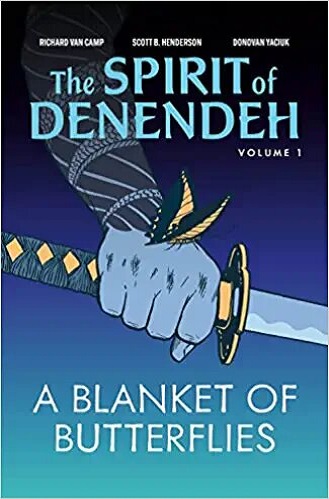No one knows how a suit of samurai armour ended up in the Fort Smith, Northwest Territories, Canada museum. When a mysterious stranger turns up to claim it, Sonny, a young Tłı̨chǫ Dene boy, is eager to help.
Shinobu has travelled to Fort Smith to reclaim his grandfather’s samurai sword and armour. But when he discovers that the sword was lost in a poker game, he must confront the man known as Benny the Bank. Along the way, Shinobu must rely on unlikely heroes ― Sonny, his grandmother and a visitor from the spirit world. Together, they face Benny and his men, including the giant they call Flinch.
Will Shinobu be able to regain the lost sword and, with it, his family’s honor? Can Sonny and his grandmother help Shinobu while keeping the peace in their community?
Now in full color, this new edition includes additional background information and cultural context. Learn about the real-life inspiration behind the story and the intersections between Indigenous and Japanese Canadian experiences during the Second World War.
The illustrations in this graphic novel are outstanding. Beautiful, elegant, powerful.
As for the story itself, it’s somewhere between interesting and contrived.
That being said, it’s always important to welcome more books, including graphic novels, to which indigenous young people can relate, and from which people of other ethnic backgrounds can learn.
The problem: Initially, without the two-page explanatory note at the back of the book, and to a lesser extent the author’s two-page foreword, the plot makes little sense. The intersection between aboriginal life and a historical Japanese artifact seems, as said, contrived. Which is a shame, because once one reads the context – that Japanese-Canadians were cruelly routed from their homes on short notice at the start of World War II, typically forced to leave worldly goods behind – one can begin to buy into the notion that a samurai sword and armour might have thus ended up in a northern Canadian museum. (This part is actually true and is what inspired the story.) Then, imagine that it might get stolen by a troubled group of indigenous men.
Stretch things further to accept that a descendant of the original Japanese owner might show up to reclaim it for his family, and a young indigenous boy might get caught between matters, as looming violence and revelation of family schisms follow. Add in a peace-seeking grandmother, a family secret and a visitor from the spirit world, and you have a story. A believable story? Maybe. It’s just a bit difficult to swallow without the context gleaned mostly from those end pages. Maybe that makes it an enjoyable read the second time around.
Certainly, fans of Japanese ninja and samurai legends, indigenous stories, magic realism and history will be its most enthusiastic readers. Others will need to work at suspending disbelief and going along for the richly illustrated ride. Then again, it makes you want to visit Fort Smith to see the mysterious suit of armour. Or just to hold this work-of-art graphic novel in your hands and let the intriguing intertwining of Japanese-Canadian and indigenous history blend.
Note that this work is part of a series of interconnected graphic novels about people living in Fort Smith. “With themes of community building and healing, the stories explore Tłı̨chǫ Dene culture and history, and how knowledge is shared across generations.” It is Volume 1 of The Spirit of Denendeh Series.
-Pam Withers


